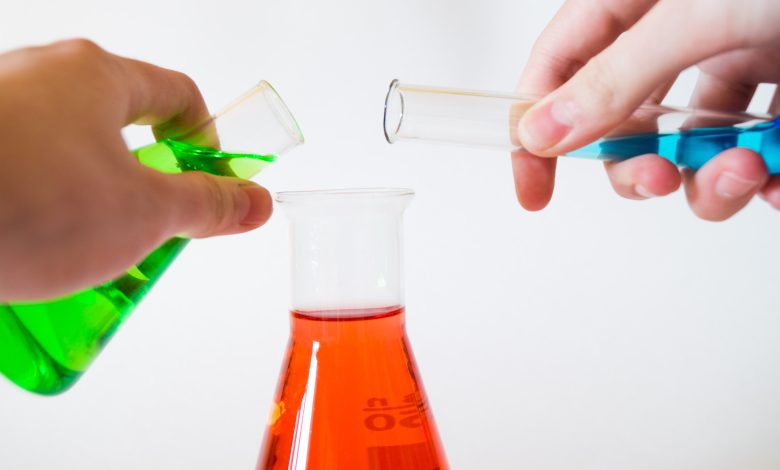
Chemical Equation:
The symbolic representation of a chemical reaction in terms of symbols, formulae, reaction parameters, conditions, enthalpies and catalyst is called a chemical equation.
The nature of chemical reactions that are taking place in a reactor can be easily studied by its chemical equation. It is a well-known fact that during chemical reactions, atoms sometimes lose electrons and they gain them often too, thus modifying their chemical formula.
Extending these symbols of both reactants and products and the exact amount of substances undergoing a chemical or physical reaction involves the writing of a balanced chemical equation.
All the chemical reactions occurring in either chemical laboratories or various process industries follow the law of conservation of mass.
Law of Conservation of Mass
This law states that atoms can neither be created nor be destroyed during a chemical reaction but they can be converted into one form to another under specified reaction parameters. If we try to understand this law, then it says that if there are A and B chemicals taking part in any form and type of a chemical reaction then there will be only said components in the product.
This is not possible that the third type of atom appears in the product stream that doesn’t find itself in the reactant stream. The overall conditions of the law of conservation of mass is accomplished by balancing a chemical equation.
Let’s us consider a chemical equation and see whether it’s balanced or not:
CH4 + 2O2 → CO2 + 2H2O
| Element | Reactant | Product | Balanced |
| C | 1 | 1 | Yes |
| H | 4 | 4 | Yes |
| O | 4 | 4 | Yes |
| Total | 9 | 9 | 18 |
Hence, the additional reaction stated above in which methane reacts with oxygen to form carbon dioxide and water is a balanced chemical equation. Hence we can balance our chemical equation by using the same method but also we can try a balancing equation calculator that will surely save our time on such a long procedure.
Role of Chemical Equation in Finding Theoretical Yields:
The relationship between chemical equations and calculating theoretical yields is very important. Theoretical yield is the conversion obtained as a result of the completion of a chemical reaction after the complete consumption of a limiting reactant.
Generally, there are two types of chemical reactions that take part in any reaction. One of them is the limiting reactant and the other is an excessive reactant. The reactants that are consumed earlier and the chemical reactions stop once it has been used completely is called limiting reactant.
Likewise, the reactant that is still available, even after the stoppage of a chemical reaction is called an excessive reaction. It is very well explained in the literature that the calculation of the theoretical yield depends on the identification of the limiting reactant. Moreover, the limiting reactant can only be identified by using a balanced chemical equation. Hence, there is a very strong role of a balanced chemical equation in calculating the theoretical and percentage yields.
This relationship can be further explained by taking an exemplary reaction. The theoretical yield will be calculated of a balanced and unbalanced chemical equation. Let us take the chemical reaction that has been explained above. 50 grams of methane reacts with 60 grams of oxygen to yield 30 grams of carbon dioxide. Calculate the theoretical yield.
Balanced Chemical Equation
CH4 + 2O2 → CO2 + 2H2O
Molar Mass of CH4= 16 g/mole
O2= 32 g/mole
CO2= 44 g/mole
H2O= 18 g/mole
CH4= 50 grams
O2= 60 grams
Amount of CO2 produced via CH4= 50 grams × moles of CH416 g× 1 mole of CO21 mole of CH4 = 3.125 moles
Amount of CO2 produced via O2= 60 grams × moles of O232 g× 1 mole of CO22 mole of O2 = 0.9375 moles
Hence, the amount of carbon dioxide produced via oxygen is less as compared to that via methane. So, we can conclude that oxygen is the limiting reactant.
Theoretical Yield= 0.9375 grams
Actual Yield= 30 grams= 30/44= 0.68 grams
Percentage Yield=Actual YieldTheoretical Yield×100
=0.680.9375×100
=72.5%
Un-Balanced Chemical Equation
10CH4 + 2O2 → CO2 + 2H2O
| Element | Reactant | Product | Balanced |
| C | 10 | 1 | No |
| H | 40 | 4 | No |
| O | 4 | 4 | Yes |
| Total | 54 | 9 | No |
The chemical reaction stated above has an unbalanced chemical equation. 50 grams of methane reacts with 60 grams of oxygen to yield 30 grams of carbon dioxide. Calculate the theoretical yield.
Molar Mass of CH4= 16 g/mole
O2= 32 g/mole
CO2= 44 g/mole
H2O= 18 g/mole
Mass of CH4= 50 grams
Molar Mass of O2= 60 grams
Actual Yield= 30 grams
Amount of CO2 produced via CH4= 50 grams × moles of CH416 g× 1 mole of CO210 mole of CH4 = 0.3125 moles
Amount of CO2 produced via O2= 60 grams × moles of O232 g× 1 mole of CO22 mole of O2 = 0.9375 moles
Now, it can be seen that the amount of product formed among both reactants is lesser for methane and thus it is our limiting reactant and oxygen is our excessive reactant.
Theoretical Yield= 0.3125 moles
Actual Yield= 30 grams= 30/44= 0.68 grams
Percentage Yield=Actual YieldTheoretical Yield×100
=0.680.3125×100
=217%
So these are the manual methods by balanced and unbalanced chemical equations to finding the theoretical yield. If someone wants to reduce his effort for finding the theoretical yield, he should try a theoretical yield calculator with steps.
Conclusion:
It can conclude from the above discussion that the role of a balanced chemical reaction in the identification of limiting and excess reactant, calculation of theoretical yield and finally the percentage yield is quite evident.
In the example narrated above, we can change the amount of methane taking part in the reaction by integer 10 which results in not only changing the limiting reactant from methane to oxygen but the theoretical yields also change massively.
Moreover, the percentage yield changed from 72% to 200% that indeed changing the overall hierarchy of our chemical reactions. Hence, it will explain by chemists that extra care should be balancing of chemical equations.
Moreover, the general practice of balancing the chemical equations states to check each atom separately. So that law of conservation of mass can satisfy and no new atoms are forming in the products streams.
From the Info posting, you can also see the many other topics. These may be helpful for you like How EMI loan calculator?




